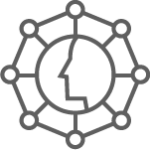Innovations – Case Study
Daman Helps the Texas
Comptroller Mind the GAAP
Consolidating a large, diverse data environment
The Challenge
Consolidating a Large, Diverse Data Environment
“I can’t trust the data in the data warehouse … There are too many universes— which one should I use? … How do I find what I’m looking for? … I want to be able to slice and dice my data.”
These are just a few of the comments from a survey of users conducted by Daman for the Office of the Texas Comptroller of Public Accounts (CPA). A key role of the CPA is to provide the public and other state institutions with data about where state revenues come from and how this money is spent. However, the Office was facing limitations in its ability to integrate, manage and provide easy access to this data for the public, as well as for their own employees and other state agencies.
Daman was asked to provide recommendations for ways to consolidate more data, remove existing gaps in data, improve access and enhance service delivery. The task wasn’t simple. The CPA has one of the largest and most complex data environments in the state government, developing and managing contracts for more than 200 state agencies and about 1,600 local governments. A number of smaller agencies use CPA systems for managing their finances. State agencies also provide data to CPA to support the creation of the consolidated Annual Financial Report, and this data often needs to be adjusted several times to ensure that all financial numbers are accurate, consistent and complete.
Daman focused on three key areas: fiscal management; unclaimed property such as forgotten bank accounts; and enforcement to manage and track delinquent taxpayer accounts for collection. Over the years, each area has developed its own, standalone reporting applications with different data preparation and delivery components to meet specific, tactical objectives. Although the CPA had developed a business intelligence / data warehouse (BI/DW) platform and supported a number of integration initiatives, progress was limited due to architecture, resource and budgetary limitations.
As a result, users were reporting missing data, inaccessible data or data not in the right format. Some state agencies noted discrepancies in their data and the numbers published in the CPA’s Annual Financial Report. Self-service was limited to canned reports without the ability to drill down to more detailed data or generate ad hoc reports. Data sharing between CPA and the other agencies was a manual, time-consuming process. In some cases, users felt it was faster and easier to bypass existing data warehouses and go directly to source systems.
How Daman Helped
Improving Integration and Self-services
After talking with users and stakeholders, Daman professionals used a business-backed approach to pinpoint key business processes and understand the current state of the BI/DW platform. They synthesized and analyzed interview feedback and other supporting material to identity and classify opportunities for improvement. Then they validated their findings by re-engaging with key stakeholders to confirm business capability needs, refine details and articulate key success factors.
Finally, the Daman team developed a comprehensive, technology roadmap to help prioritize, sequence and specify programs and projects required to optimize data management and services delivered by the CPA.
The Results
A Strategic Vision
The Daman roadmap provides a detailed, experience-tested and strategic vision for optimizing data infrastructures, streamlining operations, increasing service delivery efficiency and supporting new technology investments.
As recommended by Daman, key fiscal management systems will be designed to provide agencies with a single, intuitive entry point for easy information access, improve administration and support, increase state transparency, generate statewide reports including the Annual Financial Report, and monitor the financial integrity of the state. In addition, four HR and payroll systems will be more fully integrated into a single solution, gaps in data content will be filled, data consistency between legacy systems will be improved and operating costs will be reduced through ETL automation, common standards, quality frameworks and better metadata management.
Self-service will also be enhanced. Users will be able to support their information needs without calling the support team or having to process, aggregate or massage the data before finding the information they need. Users can also create custom reports or take advantage of templates to create entirely new reports while addressing other information needs through an enhanced BI/DW platform.
At the same time, the CPA will be able to hasten the migration to its PeopleSoft environment, thereby helping to improve reporting capability; enhance data availability and functionality of public websites; and migrate away from legacy technologies.
In short, the Daman technology roadmap can be used to help the CPA better serve the current needs of Texas today while providing strategic guidance for new technology investments in the years ahead.



